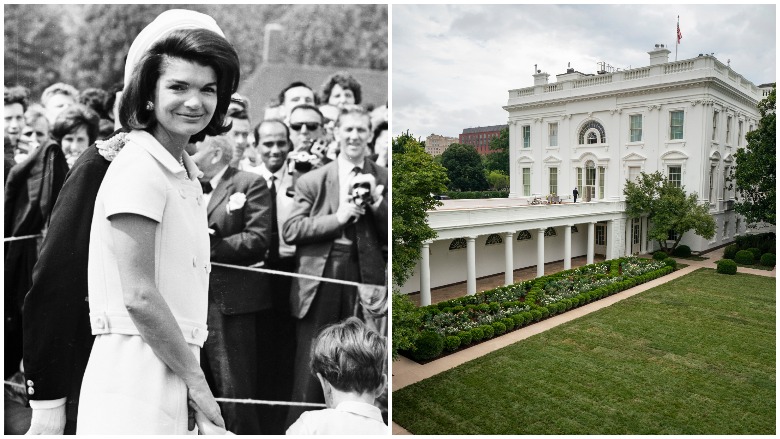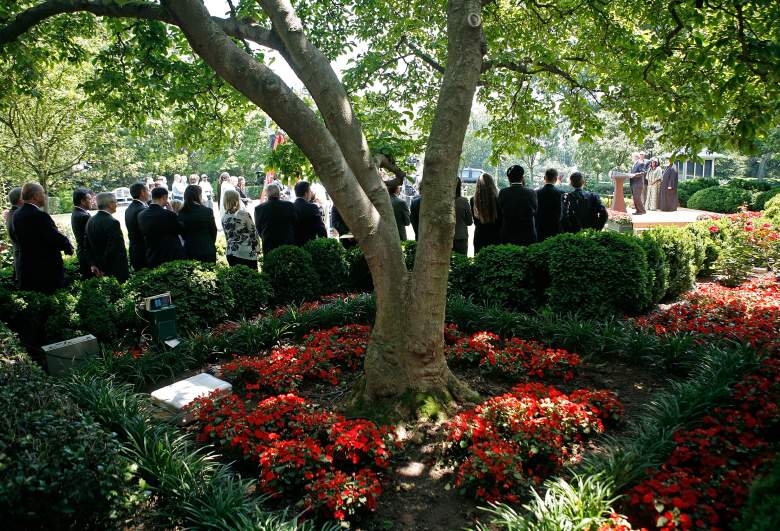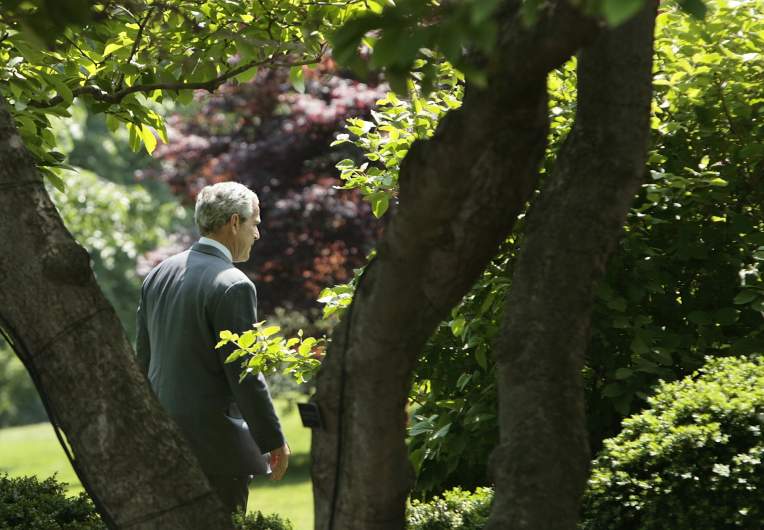
The Rose Garden has been an iconic part of the White House grounds throughout Presidential history, but its 1962 design under the Kennedy Administration and First Lady Jackie Kennedy laid the blueprint for decades to come.
First Ladies played varying roles in the rose garden, which was formally named in 1913 following a redesign by First Lady Ellen Wilson in 1902. Throughout the years, it has housed stables, greenhouses and carriages. Even before it was formally named, the most common feature of the garden was roses. The 1962 design was completed under the direction of President John F. Kennedy and First Lady Jacqueline Kennedy, and designed by Rachel Lambert Mellon, a friend of the Kennedys. Read about First Lady Melania Trump’s redesign of the rose garden and see before and after photos here.
“Twenty years have gone by. The Rose Garden has seen administrations come and go,” Mellon wrote in an essay about the garden in 1983. “It is now known the world over. It has fulfilled John F. Kennedy’s vision of a garden that would endure and whose atmosphere, with the subtlety of its every changing patters, would suggest the every changing pattern of history itself.”
Here’s what you need to know:
A Magnolia Tree at the Rose Garden Dated Back to Andrew Jackson & More Were Added Under the Kennedy Administration
Magnolia trees were a highlight of the White House rose garden for decades, and more were added in the 1962 renovation. Before its design under the Kennedy administration in 1962, a magnolia tree dating back to Andrew Jackson stood near the oval office. Designer Rachel Lambert Mellon was commissioned by John F. Kennedy to complete the project in 1961.
“I vividly remember my first impression of the scene and the setting for the projected garden. The White House proper seemed exceptionally tall where it joined the long, low colonnade that linked it to the Oval Office and Cabinet Room. There were no trees near this wing or the corner by the White House, except for Andrew Jackson’s tall, dark Magnolia grandiflora near the South Portico. Beneath the magnolias was a long semicircular white bench on which Perry Wheeler and I sat facing the President’s office,” Mellon wrote in an essay.
While she was trying to determine ideas for the project, she came across magnolia trees in New York and became inspired, according to her essay.

GettyUS President Barack Obama walks around the Rose Garden under a colorful Magnolia tree on the way to the Oval Office of the White House April 10, 2014 after he returned from his two-day trip to Texas. AFP Photo/Paul J. Richards (Photo credit should read PAUL J. RICHARDS/AFP via Getty Images)
Mellon wrote:
After that first impression of the garden and my talk with the President, my sense of responsibility for redesigning the garden was very strong. I hoped to find an inspiration that would help me bring all of the President’s requirements together. It was not until the end of October—the trees had lost their leaves—when late one afternoon, cold with the feeling of approaching winter and descending darkness, I was walking along Fifth Avenue in New York and looked up and saw three lovely magnolia trees growing in front of the Frick museum. I had often admired these trees before, but this evening they had a special importance to me. Their pale silvery branches with heavy twigs seemed to retain the light of summer. I knew their pattern of growth would continue to give form in winter and would catch raindrops as well as tufts of falling snow. I felt I could now design the President’s garden!
About a dozen crabapple trees were removed under Melania Trump’s renovation, and will be replanted elsewhere on the White House grounds, according to USA Today.
Presidents & First Ladies Planted & Redesigned Gardens Over the Decades, But All the Gardens Included Roses

GettyWASHINGTON, DC – AUGUST 22: A view of the recently renovated Rose Garden at the White House on August 22, 2020 in Washington, DC. The Rose Garden has been under renovation since last month and updates to the historic garden include a redesign of the plantings, new limestone walkways and technological updates to the space. (Photo by Drew Angerer/Getty Images)
Many aspects of the Kennedy Rose Garden paid tribute to past Presidents. The 1962 design included flowers from the period of Thomas Jefferson, inspired by Kennedy’s reading of Jefferson’s gardening notes, Mellon wrote in her essay. First Lady Jacqueline Kennedy’s involvement with the rose garden was driven by historic preservation, according to the JFK Library.
“Mrs. Kennedy’s interests in historic preservation went beyond the White House walls. She asked her friend, Rachel “Bunny” Mellon, to redesign the president’s Rose Garden. She envisioned the garden as a natural sanctuary and retreat just outside the Oval Office and an ideal space for greeting special visitors and large groups,” a report on the JFK Library website said.
The first known rose garden at the White House was “a dream-like Victorian garden under glass,” Mellon wrote in her essay, and part of a complex of greenhouses. Other plantings included palms, orchids, fruit trees, and camellias.

GettyWASHINGTON – MAY 30: White House staff and officials stand in the Rose Garden while listening to U.S. President George W. Bush (R) speaks about AIDs during a news conference at the White House May 30, 2007 in Washington DC. The president wants Congress to fund 30 billion dollars to fight AIDS around the world. (Photo by Mark Wilson/Getty Images)
Before the first formal garden in 1902, the rose garden grounds included stables and carriages. A conservatory rose house stood among the grounds, near the present-day Oval Office and Cabinet Room, according to the White House Museum.
First Lady Edith Kermit Roosevelt removed the greenhouses and designed what she called the “Colonial Garden” in 1902. She planted sweet peas, black-eyed susans, quince and jasmine. Under President Howard Taft’s presidency, First Lady Helen Herron Taft preferred tropical plants indoors to the garden.
The garden has been called a “rose garden” since 1913 when First Lady Ellen Wilson replaced the Colonial Garden with a formal rose garden, according to the White House Museum.
“The one flower that unites all the occupants through the history of the White House is the rose,” Mellon wrote. “Thus, for most of the 20th century, the Rose Garden has been a rose garden. Now, in 1961, President Kennedy wanted it restored in spirit but revised to become more than just a private garden.”
Melania Trump’s Redesign Was Aimed to Reflect the Original 1962 Design
Melania Trump said in a White House statement the White House Rose Garden renovation was aimed to reflect the history of the rose garden and its 1962 design under President John F. Kennedy and Jackie Kennedy. Read more about the changes and see before and after photos here.
“The plan will provide a renewal of the design first implemented by Rachel Lambert ‘Bunny’ Mellon during the Kennedy Administration, which has been the guiding blueprint for the Rose Garden since that installation in 1962. Decades of use and necessary changes made to support the modern presidency have taken a toll on the garden and have made it more difficult to appreciate the elegant symmetry of the Mellon plan,” the statement said.

GettyWASHINGTON – APRIL 25: United States President George W. Bush leaves the Rose Garden after awarding the United States Naval Academy football team with the Commander In Chief’s Trophy at the White House April 25, 2006 in Washington, DC. The Naval Academy beat the Air Force and Army football teams to win the title for the third year in a row. (Photo by Chip Somodevilla/Getty Images)
Changes included removing about a dozen crabapple trees which will be replanted elsewhere on the White House grounds. A seating area was also removed, and will be replaced by an art installation, according to USA Today. A limestone walkway was also added to the rose garden.
“The very act of planting a garden involves hard work and hope in the possibility of a bright future,” said First Lady Melania Trump in the statement. “Preserving the history and beauty of the White House and its grounds is a testament to our nation’s commitment to the care of this landscape and our dedication to American ideals, safeguarding them for our children and their children for generations to come.”
READ NEXT: Rose Garden Before & After Melania Trump’s Changes [Photos]




